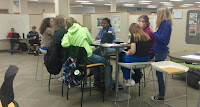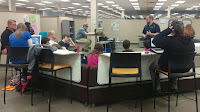The Process
Our process begins with a team meeting. Using Google Sheets, Briana created the Holy Grail of data collection spreadsheets. On our sheet we track all things from "D/Fs" per subject, parent contact, interventions being provided and assignment completion. This data allows us to get a better picture of the student as a whole as opposed to the snap shot of a student that we got when we were in a traditional setting.
We begin the team meeting by updating our "D/F" list so we are working with current data. From there we discuss each "struggling" student and develop an action plan.
Interventions
We have a standard list of our go to interventions that we like to pull from. That list includes the following:
- Room 500- this room is used for our quiet work and testing. Minimal talking is allowed. Great space for students who are struggling with focus or just need a quiet space.
- Assigned seating- typically just need a better choice made for them about who they are sitting next to
- List of missing work- with the students in charge of their own learning sometimes all they need is a "to do" list to get them back on the right track.
- No Phone- The lifeline of all teenagers. We use a "phone jail" and just have students toss them in there
- Pull from lab- the lab is the reason our students come to us, and typically something they absolutely love. Thankfully, our lab instructors are great about making sure core academics are a priority. Typically, pulling a student from lab is a great motivator to get back on track
- Email lab instructor- sometimes all a student needs is a pep talk (or stern warning) from their lab instructor. We also just like to keep them in the loop with how things are going and making sure we all have the best picture of the student as a whole as we can
- Parent Contact- Our goal is to create a self motivated learner however we have really tried to increase parental involvement and when all else fails the parent call or email home is always a go to.
The above is simply our starter interventions from there we discuss other options such as scheduling one on one time with a teacher, encouraging retakes or deciding what topics students need remediation on. We also keep a running tally of the interventions we use for each student so that we can see what is effective and what is not.
The Impact
We've only been implementing this for a little over 15 weeks so the true impact is yet to be seen. In the short term though we have seen our number of failures in the first quarter drop by about 23%. With the end of the semester on the horizon we will see if that number changes. Data aside these focused team meetings have spurred many educational conversations about student learning and struggles that I had not been apart of before. I've also heard comments from all of my team members that they feel like they have a much better idea about what is going on in all classes and have a much better picture about our students as a whole. So overall, this approach has been a big positive for our south academic team
Have a better approach to student intervention or ideas to improve ours? Leave us a comment. We'd love to hear from you.



































